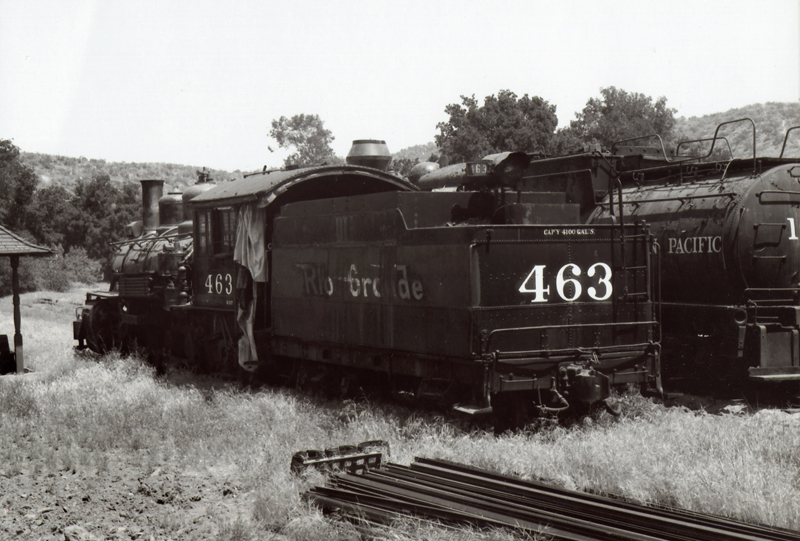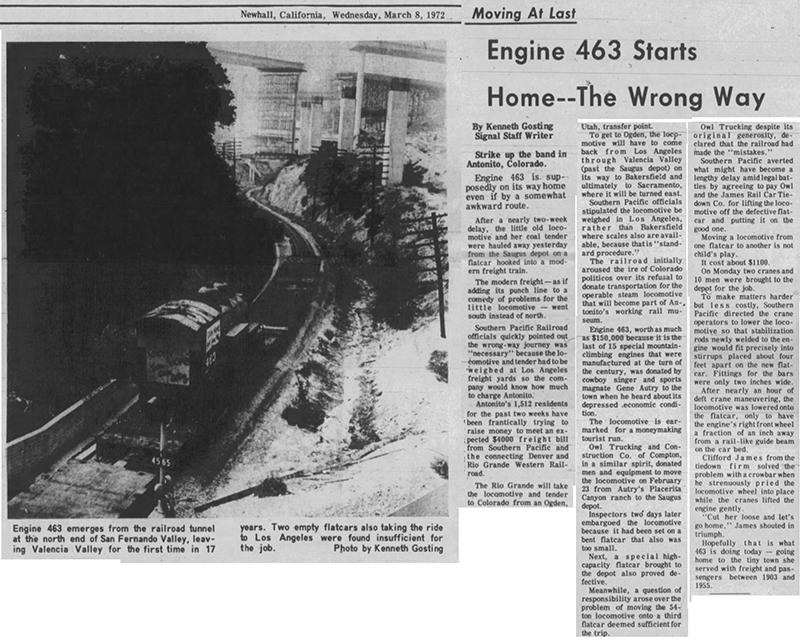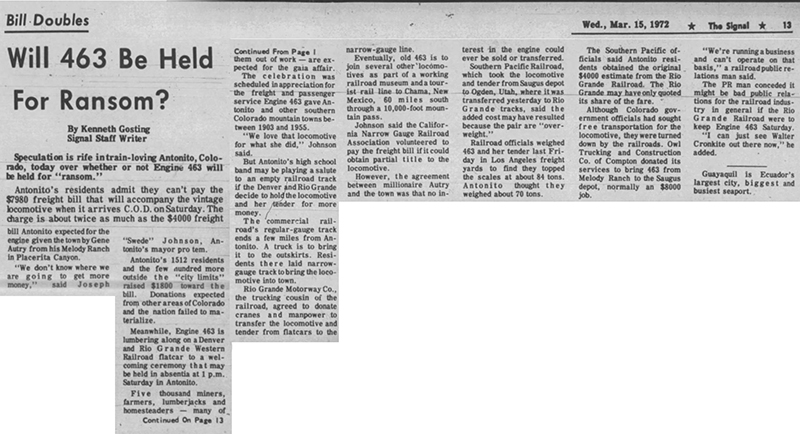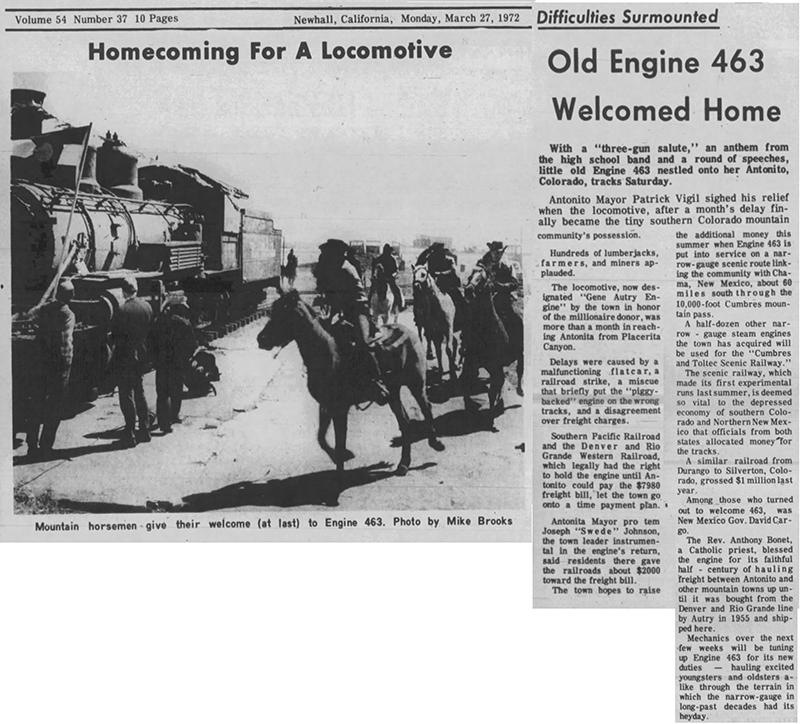|
|
Melody Ranch, Placerita Canyon

Click image to enlarge
Two of the locomotives that actor Gene Autry collected, sitting in the boneyard at his Melody Ranch in Placerita Canyon, probably after 1962 and no later than 1972, when Autry donated the 2-8-2 engine in the foreground to the Denver & Rio Grande Railroad (see below). We can't positively identify the engine behind it from a single visible numeral, but it's probably the 2-6-0 Mogul No. 1629, which Autry donated in 1982 to the Santa Clarita Valley Historical Society.
About Engine 463. Known as "mudhens" because they would frequently derail on lighweight rails and scoot across the ties like a waddling hen, Engine 463 is a narrow gague (3-foot) K-27 class 2-8-2 built by Baldwin Locomotive Works in 1903 and used until 1955 on the Silverton (Southern) Branch of the Denver & Rio Grande Railroad (renamed Denver & Rio Grande Western Railroad in 1924). Engine 463 is one of only two surviving K-27s. Gene Autry purchased the locomotive in 1955 after it was retired from service and kept it at his Melody Ranch studio in Placerita Canyon, which he intended to transform into a Western museum. Engine No. 463 was used as a movie prop (as were other retired locomotives, including the Mogul Engine No. 1629, which Autry later gave to the Santa Clarita Valley Historical Society) until a 1962 wildfire devastated the property and dashed his plans. The 463 was a derelict when, in March 1972, Autry "returned" it to the town of Antonito, Colo., for the new Cumbres & Toltec Scenic Railroad, which the states of Colorado and New Mexico jointly created in 1970 when they purhcased the line between between Chama, N.M., and Antonito from the old Denver and Rio Grande Western Railroad. The trip home was a comedy of errors, some not so funny. Autry agreed to give the engine and tender to Antonito on condition the town pay the estimated $4,000 shipping cost. Owl Trucking and Construction Co. of Compton donated its services to bring No. 463 and its tender from Melody Ranch to the SPRR Saugus depot (in Saugus) — normally an $8,000 job (The Signal, March 15, 1972.) Loaded onto a flatcar that was part of a regular Southern Pacific freight train, the engine and tender were sent it to Los Angeles to be weighed, in order to calculate the freight bill. It came in at double the expected amount — $7,980. The tiny town of 1,512 souls couldn't afford it. After some haggling, they were allowed to make payments. Duly weighed, the first flatcar was found to be too small, and the second was defective. Each move from one flatcar to another was a $1,100 job that involved 10 men, and it didn't go smoothly. Eventally the package was on its way; the SPRR shipped the engine and tender to Ogden, Utah, where they changed tracks (to the Rio Grande tracks) and headed east to Colorado, arriving March 25, 1972. The town of Antonito handed over the engine and tender to the Cumbres & Toltec to restore. The restoration was complete in 1994, and No. 463 began to transport tourists. Engine 463 threw a side rod in 2002 and was taken out of service. In 2009, it was moved to the railroad's shop at Chama, where it was rebuilt. It returned to service in Spring 2013. As of 2015 it is the smallest engine on the line. A tourist line that uses part of the San Joan Extension of the Denver & Rio Grande, the C and TS is still owned and administered jointly by New Mexico and Colorado. It is America's longest and highest narrow-gauge railroad and is listed on the National Register of Historic Places. It is leased to a private operator who is responsible for carrying tourists on scheduled rides and maintaining the rolling stock and the associated rail museum.
About Engine No. 1629.
About Engine No. 1629. Southern Pacific Mogul Engine No. 1629 is a class M4 steam locomotive (initially class ED) weighing 75 tons — "mogul" being the name for locomotives with a 2-6-0 wheel configuration (two leading wheels on one axle, six powered and coupled driving wheels on three axles, no trailing wheels). The engine was built in November 1900 by Schenectady Locomotive Works of New York and placed into service by the Southern Pacific Railroad on December 6, 1900, for light freight service on the line that ran from Yuma, Ariz., to Portland, Ore., passing through the Santa Clarita Valley. No. 1629 was one of 75 moguls that the Southern Pacific received from Schenectady and from Cooke of New Jersey during 1900 and 1901. In the latter year the two manufacturers merged with seven others to form American Locomotive Company (ALCO). The SP wasn't ordering locomotives from the big dog, Baldwin, at the time, because of a dispute between SP President Collis P. Huntington and Baldwin that dated back to the construction of the Central Pacific Railroad in the 1860s. The SP changed its policy and started ordering most of its locomotives from Baldwin following Huntington's death in August 1900. Apparently the order was already placed or the policy hadn't yet changed by the time our locomotive was ordered from Schenectady, where it was given a sequential manufacturing number of 5680. It's uncertain whether Schnectady rigged No. 1629 to burn coal or oil for fuel. Between 1905 and 1910, the Southern Pacific would convert its entire fleet to oil burners (Hungerford 1959:9); it's possible No. 1629 was oil-fired from birth. Initially, the engine number ("1629") would have appeared on the tender and the railroad's name in Roman lettering on the cab. Beginning in 1916, the scheme was changed to the number on the cab and "SOUTHERN PACIFIC LINES" on the tender. After 1946, the lettering was abbreviated to "SOUTHERN PACIFIC," and the front of the boiler (or "nose") and the smokebox were changed from all-black to (metallic gray) graphite linseed oil paint. In all cases, it took a couple of years for the changes to be implemented fleet-wide. Records indicate No. 1629 was either retrofitted or overhauled August 25, 1928, at the SPs' Sacramento shops. After World War II, when the Southern Pacific and other lines were scrambling to renew their fleets after a wartime halt to regular locomotive production, No. 1629 was leased for two short months to the Southern Pacific of Mexico (Sud-Pacífico de México) — March 16, 1946, to May 10, 1946. Although a subsidiary of the Southern Pacific, SPdeM had a separate corporate structure because Mexico required railroad companies to be domiciled in Mexico. (The same was true of another SP subsidiary, Texas & New Orleans, because Texas had the same requirement.) No. 1629 officially retired from service at Tucson on May 1, 1957 — the year the steam era ended on the Southern Pacific, fully replaced by diesel. Western actor Gene Autry purchased the old workhorse and added it to his new and growing collection of locomotives at his Melody Ranch studio in Placerita Canyon. Engine No. 1629 was his fifth such acquisition; it was delivered June 17, 1957 (The Signal, June 20, 1957). It reportedly appeared in Melody Ranch-based television series such as "Gunsmoke" and "The Life and Legend of Wyatt Earp." No. 1629 was no stranger to the camera. According to the Arizona Daily Star, its film career actually started while still in active service in the SP's Tucson division, having appeared in some 20 movies made in Southern Arizona before 1957. According to The Signal, in the late 1950s Autry was planning to open Melody Ranch to the public and was preparing to lay track for a narrow-gauge train that would take tourists on rides around the ranch. It was part of his plan to open a Western museum on the property. The 1962 fire snuffed out that idea — but luckily, it didn't completely kill it. Autry would see his dream come true at Griffith Park in 1988. By that time, Autry had donated Engine No. 1629 to the Santa Clarita Valley Historical Society. Offered in 1981, it was moved with donated funds April 22, 1982, to its present location next to the Saugus Depot where it has been restored as a static display. Principal source for manufacturing information: Diebert & Strapac 1987.
LW2750: 19200 dpi jpeg from 8x10 glossy copy print (printed on Fujicolor Crystal Archive paper, which was introduced Nov. 30, 1997). |
Train Collection
|
The site owner makes no assertions as to ownership of any original copyrights to digitized images. However, these images are intended for Personal or Research use only. Any other kind of use, including but not limited to commercial or scholarly publication in any medium or format, public exhibition, or use online or in a web site, may be subject to additional restrictions including but not limited to the copyrights held by parties other than the site owner. USERS ARE SOLELY RESPONSIBLE for determining the existence of such rights and for obtaining any permissions and/or paying associated fees necessary for the proposed use.











